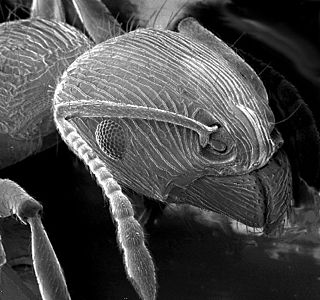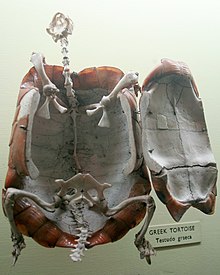
Branchiopoda is a class of crustaceans. It comprises fairy shrimp, clam shrimp, Diplostraca, Notostraca and the Devonian Lepidocaris. They are mostly small, freshwater animals that feed on plankton and detritus.

Arachnida is a class of joint-legged invertebrate animals (arthropods), in the subphylum Chelicerata. Arachnida includes, among others, spiders, scorpions, ticks, mites, pseudoscorpions, harvestmen, camel spiders, whip spiders and vinegaroons.

The Opiliones are an order of arachnids colloquially known as harvestmen, harvesters, harvest spiders, or daddy longlegs. As of April 2017, over 6,650 species of harvestmen have been discovered worldwide, although the total number of extant species may exceed 10,000. The order Opiliones includes five suborders: Cyphophthalmi, Eupnoi, Dyspnoi, Laniatores, and Tetrophthalmi, which were named in 2014.

Malacostraca is the largest of the six classes of crustaceans, containing about 40,000 living species, divided among 16 orders. Its members, the malacostracans, display a great diversity of body forms and include crabs, lobsters, crayfish, shrimp, krill, prawns, woodlice, amphipods, mantis shrimp, tongue-eating lice and many other less familiar animals. They are abundant in all marine environments and have colonised freshwater and terrestrial habitats. They are segmented animals, united by a common body plan comprising 20 body segments, and divided into a head, thorax, and abdomen.

Ostracods, or ostracodes, are a class of the Crustacea, sometimes known as seed shrimp. Some 70,000 species have been identified, grouped into several orders. They are small crustaceans, typically around 1 mm (0.04 in) in size, but varying from 0.2 to 30 mm in the case of Gigantocypris. Their bodies are flattened from side to side and protected by a bivalve-like valve or "shell" made of chitin, calcium carbonate and protein. The hinge of the two valves is in the upper (dorsal) region of the body. Ostracods are grouped together based on gross morphology. While early work indicated the group may not be monophyletic and early molecular phylogeny was ambiguous on this front, recent combined analyses of molecular and morphological data found support for monophyly in analyses with broadest taxon sampling.

Solifugae is an order of animals in the class Arachnida known variously as camel spiders, wind scorpions, sun spiders, or solifuges. The order includes more than 1,000 described species in about 147 genera. Despite the common names, they are neither true scorpions, nor true spiders. Most species of Solifugae live in dry climates and feed opportunistically on ground-dwelling arthropods and other small animals. The largest species grow to a length of 12–15 cm (5–6 in), including legs. A number of urban legends exaggerate the size and speed of the Solifugae, and their potential danger to humans, which is negligible.

Isopoda is an order of crustaceans that includes woodlice and their relatives. Isopods live in the sea, in fresh water, or on land. All have rigid, segmented exoskeletons, two pairs of antennae, seven pairs of jointed limbs on the thorax, and five pairs of branching appendages on the abdomen that are used in respiration. Females brood their young in a pouch under their thorax.

A scute or scutum is a bony external plate or scale overlaid with horn, as on the shell of a turtle, the skin of crocodilians, and the feet of birds. The term is also used to describe the anterior portion of the mesonotum in insects as well as some arachnids.

The cephalothorax, also called prosoma in some groups, is a tagma of various arthropods, comprising the head and the thorax fused together, as distinct from the abdomen behind.. The word cephalothorax is derived from the Greek words for head and thorax. This fusion of the head and thorax is seen in chelicerates and crustaceans; in other groups, such as the Hexapoda, the head remains free of the thorax. In horseshoe crabs and many crustaceans, a hard shell called the carapace covers the cephalothorax.

The decapod is made up of 20 body segments grouped into two main body parts: the cephalothorax and the pleon (abdomen). Each segment may possess one pair of appendages, although in various groups these may be reduced or missing. They are, from head to tail:

The superorder Peracarida is a large group of malacostracan crustaceans, having members in marine, freshwater, and terrestrial habitats. They are chiefly defined by the presence of a brood pouch, or marsupium, formed from thin flattened plates (oostegites) borne on the basalmost segments of the legs. Peracarida is one of the largest crustacean taxa and includes about 12,000 species. Most members are less than 2 cm (0.8 in) in length, but the largest is probably the giant isopod which can reach 76 cm (30 in). The earliest known perecaridian was Oxyuropoda ligioides, a fossil of which has been found dating to the Late Devonian of Ireland.

The eastern long-necked turtle is an east Australian species of snake-necked turtle that inhabits a wide variety of water bodies and is an opportunistic feeder. It is a side-necked turtle (Pleurodira), meaning that it bends its head sideways into its shell rather than pulling it directly back.

Cumacea is an order of small marine crustaceans of the superorder Peracarida, occasionally called hooded shrimp or comma shrimp. Their unique appearance and uniform body plan makes them easy to distinguish from other crustaceans. They live in soft-bottoms such as mud and sand, mostly in the marine environment. There are more than 1,500 species of cumaceans formally described. The species diversity of Cumacea increases with depth.

Triops longicaudatus is a freshwater crustacean of the order Notostraca, resembling a miniature horseshoe crab. It is characterized by an elongated, segmented body, a flattened shield-like brownish carapace covering two thirds of the thorax, and two long filaments on the abdomen. The genus name Triops comes from Greek ὤψ or ṓps, meaning "eye" prefixed with Latin tri-, "three", in reference to its three eyes. Longicaudatus is an Latin neologism combining longus ("long") and caudatus ("tailed"), referring to its long tail structures. Triops longicaudatus is found in fresh water ponds and pools, often in places where few higher forms of life can exist.

Opiliones are an order of arachnids and share many common characteristics with other arachnids. However, several differences separate harvestmen from other arachnid orders such as spiders. The bodies of opiliones are divided into two tagmata : the abdomen (opisthosoma) and the cephalothorax (prosoma). Unlike spiders, the juncture between the abdomen and cephalothorax is often poorly defined. Harvestmen have chelicerae, pedipalps and four pairs of legs. Most harvestmen have two eyes, although there are eyeless species.

The turtle shell is a shield for the ventral and dorsal parts of turtles, completely enclosing all the vital organs of the turtle and in some cases even the head. It is constructed of modified bony elements such as the ribs, parts of the pelvis and other bones found in most reptiles. The bone of the shell consists of both skeletal and dermal bone, showing that the complete enclosure of the shell likely evolved by including dermal armor into the rib cage.

Arthropods are covered with a tough, resilient integument or exoskeleton of chitin. Generally the exoskeleton will have thickened areas in which the chitin is reinforced or stiffened by materials such as minerals or hardened proteins. This happens in parts of the body where there is a need for rigidity or elasticity. Typically the mineral crystals, mainly calcium carbonate, are deposited among the chitin and protein molecules in a process called biomineralization. The crystals and fibres interpenetrate and reinforce each other, the minerals supplying the hardness and resistance to compression, while the chitin supplies the tensile strength. Biomineralization occurs mainly in crustaceans. In insects and arachnids, the main reinforcing materials are various proteins hardened by linking the fibres in processes called sclerotisation and the hardened proteins are called sclerotin. The dorsal tergum, ventral sternum, and the lateral pleura form the hardened plates or sclerites of a typical body segment.

Crustaceans may pass through a number of larval and immature stages between hatching from their eggs and reaching their adult form. Each of the stages is separated by a moult, in which the hard exoskeleton is shed to allow the animal to grow. The larvae of crustaceans often bear little resemblance to the adult, and there are still cases where it is not known what larvae will grow into what adults. This is especially true of crustaceans which live as benthic adults, more-so than where the larvae are planktonic, and thereby easily caught.
The cephalon is the head section of an arthropod. It is a tagma, i.e., a specialized grouping of arthropod segments. The word cephalon derives from the Greek κεφαλή (kephalē), meaning "head".

Crustaceans belong to the subphylum Crustacea, and form a large, diverse group of arthropods including decapods, seed shrimp, branchiopods, fish lice, krill, remipedes, isopods, barnacles, copepods, amphipods and mantis shrimp. The crustacean group can be treated as a subphylum under the clade Mandibulata. It is now well accepted that the hexapods emerged deep in the Crustacean group, with the completed group referred to as Pancrustacea. Some crustaceans are more closely related to insects and the other hexapods than they are to certain other crustaceans.




















